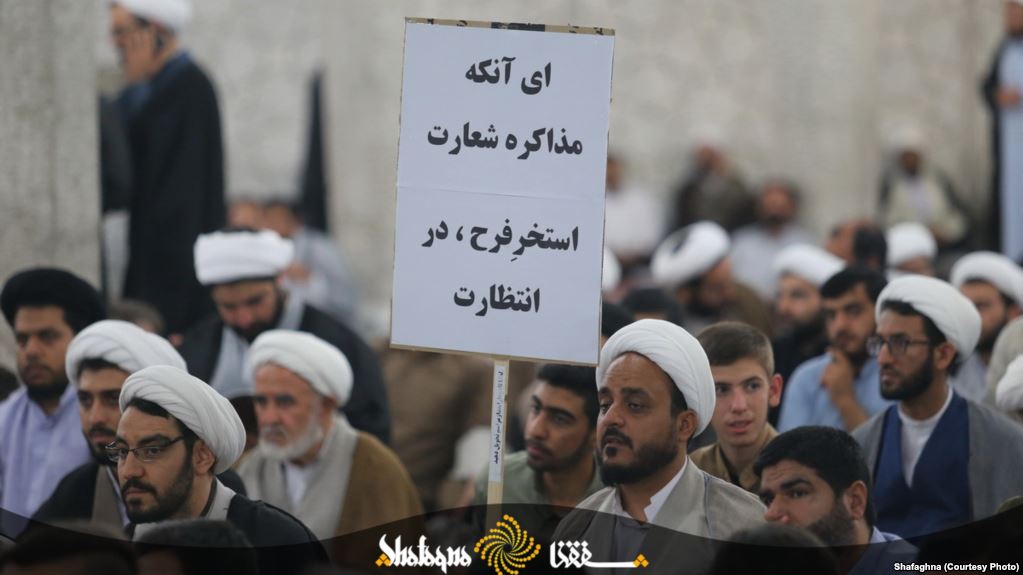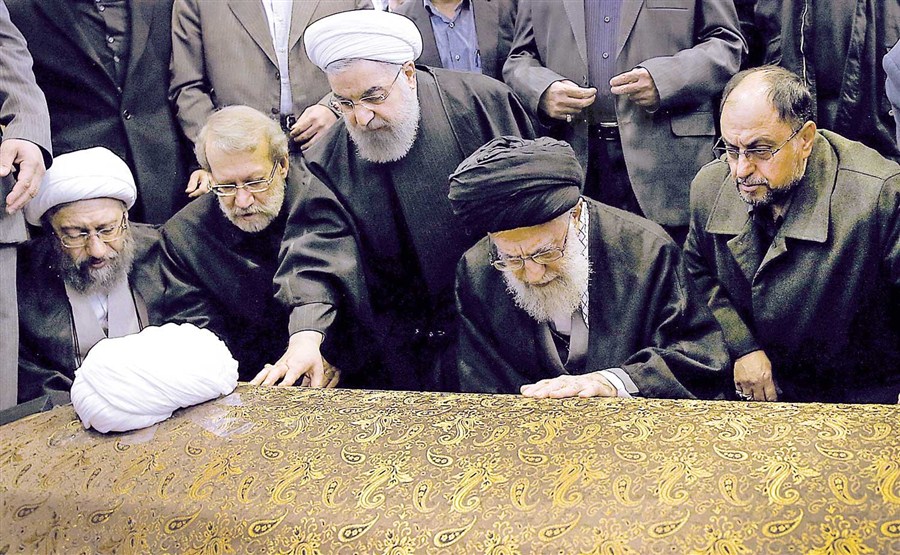Special to WorldTribune.com
By Golnaz Esfandiari, Radio Free Europe / Radio Liberty
A perceived death threat against President Hassan Rouhani within the seminary of the holy Shi’ite city of Qom has led to controversy in Iran, with some calling it a disaster for the seminary — home to thousands of influential clerics and theology students — and others demanding an investigation.

A commander of the powerful Islamic Revolutionary Guards Corps (IRGC) was reported to have been among the speakers at the event, which was held amid a sharp fall of the Iranian currency and rising prices on food and other basic goods.
The sign suggested that those who are in favor of negotiations with the United States could meet the same fate as former President Akbar Hashemi Rafsanjani, a onetime Rouhani ally whose 2017 death was blamed on a heart attack but has been described by some, including family members, as suspicious.
“You whose slogan is negotiation, expect [to end up] in Farah’s swimming pool,” the sign, widely shared on social media, said in a presumed reference to Farah Pahlavi, the widow of the late shah, Mohammad Reza Pahlavi.
Rafsanjani was reportedly found dead by his bodyguards in a swimming pool in the Iranian capital where he used to swim regularly. He was 82.
Seemingly unsubstantiated claims followed suggesting that he had been drowned or poisoned. There were also allegations by some hard-liners that Rafsanjani had died in a swimming pool that once belonged to the Pahlavi regime, which was brought down by Iran’s 1979 revolution.
Death Threat?
The sign at the Qom seminary protest was quickly interpreted as a death threat against second-term President Rouhani, who has been criticized by conservatives in particular over his outreach efforts toward the West, most notably through negotiations with the previous U.S. administration that resulted in the 2015 nuclear deal that President Donald Trump recently abandoned.
Protesters at the August 16 gathering expressed support for comments by Supreme Leader Ayatollah Ali Khamenei, who earlier in the week had banned talks with the United States while also suggesting he had made a mistake by allowing Rouhani’s government to negotiate with Washington.
Khamenei, who as supreme leader holds the final word on religious and political matters in Iran, also said that mismanagement hurts the Iranian economy more than U.S. sanctions that were reimposed earlier this month following Trump’s announcement in May to withdraw from the so-called Joint Comprehensive Plan of Action (JCPOA), whose signatories include all five permanent members of the UN Security Council along with Germany and the European Union, in addition to Iran.
“In fact, this slogan means, ‘Mr. President, we will get rid of you, as we did with Hashemi Rafsanjani,” deputy parliament speaker Ali Motahari, who urged the Intelligence Ministry to investigate the incident, said.

He added that an investigation could offer clues into the death of Rafsanjani, which, he said remained a mystery.
Motahari said signs and slogans at the August 16 protest demonstrated that a segment of those attending the Qom seminary are facing “social and political degeneration.”
Qom is a global hub of Shi’ite scholarship and a key player in the battles for influence and power in Iran, whose population is thought to be over 90 percent Shi’ite.
Other comments, including from the conservative daily Jomhuri Eslami, suggested that stickers on the protest banners that said “return after the event” were proof that a “certain” political group organized the gathering.
Senior Qom-based hard-line cleric Nasser Ayatollah Makarem Shirazi said the incident was a “total disaster” for the Qom seminary, where he noted that many Iranian leaders, including revolutionary leader Ayatollah Ruhollah Khomeini, received their training.
Makarem said those in charge of the seminary should explain who permitted the “damaging event,” adding that IRGC commanders should also explain whether they authorized their members to attend the gathering.
“Who ordered that the honor of Shi’a should be brought into question and the enemy made…happy?” Makarem asked in an August 20 statement posted by semiofficial ISNA news agency.
Pro-reform cleric Ahmad Montazeri, the son of the late dissident Ayatollah Hossein Ali Montazeri, told RFE/RL’s Radio Farda that Iran’s military and security apparatus was involved in the incident, although he did not offer specific evidence.
“There are certain groups that believe they own the country, they feel they represent Islam, they are in military bodies as well security bodies, they can do whatever they want. They can even go as far as giving signs to theology students and threatening the country’s elected president with murder,” Montazeri said in a telephone interview from Qom.
Amid the controversy, former lawmaker Hamid Rasaei, a critic of Rouhani and the nuclear negotiations, said that the sign in question, which he said was in poor taste, did not constitute a threat against the Iranian president.
“It means that whoever is optimistic about talks with the Great Satan will die in abjection,” Rasaei was quoted as saying by Iranian media. “Pro-government media are trying to magnify the issue and distract the public opinion from other problems, such as skyrocketing prices and economic pressure.”
